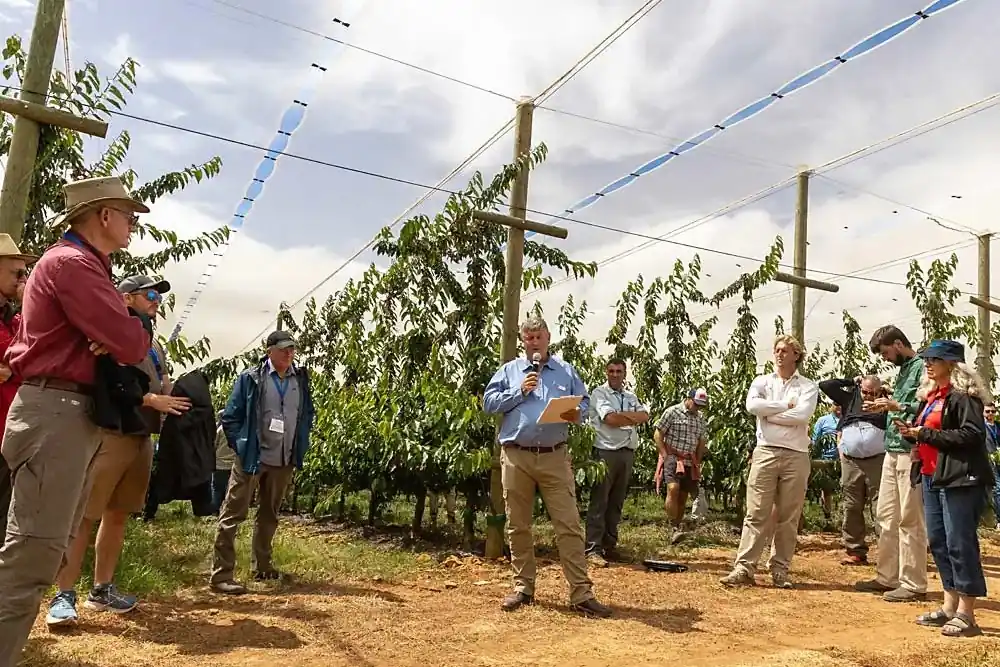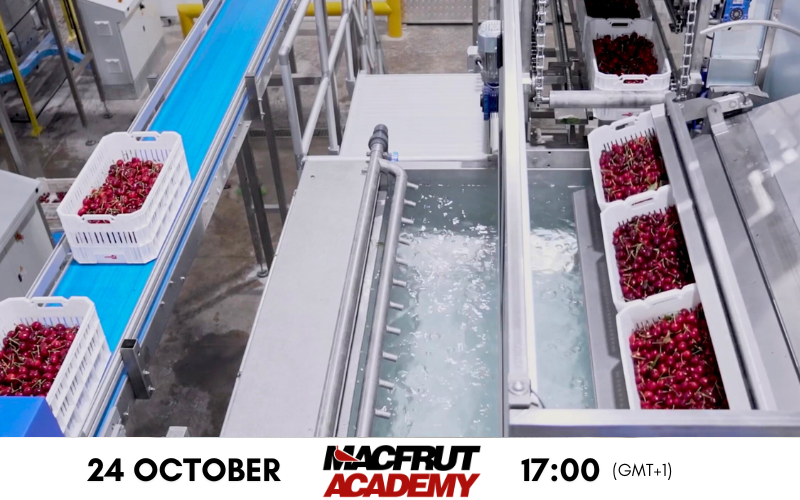In the heart of the mountainous Koue Bokkeveld region, South Africa’s cherry industry is gaining momentum thanks to low-chill cultivars and advanced orchard systems.
Sweet cherries are an emerging crop in South Africa, but they are gaining ground due to the introduction of low-chill varieties that are increasingly suited to local conditions. Most of the new plantings are concentrated in the Koue Bokkeveld region, near Ceres, a mountainous area of the Western Cape with a colder climate than other fruit-growing regions.
Last December, the International Fruit Tree Association visited Dutoit Agri in the area, exploring a fourth-leaf orchard planted with Lapins and Royal Helen cultivars. Fruit quality is the top priority, explains Piet Bosman, Dutoit’s technical advisor for cherries. To withstand the four to six weeks of sea transport to Europe and the Middle East — key export markets — the cherries must maintain high firmness. Part of the crop, about half of the 2,600 metric tons harvested in the 2023–24 season, is also shipped by air.
 Image 1. Piet Bosman, center, of Dutoit Agri, one of South Africa’s largest tree fruit producers, speaks with members of the International Fruit Tree Association about the company’s experience learning to grow sweet cherries — a relatively new crop for the country — during a December 2024 tour in the Koue Bokkeveld region. (Source: Kate Prengaman/Good Fruit Grower)
Image 1. Piet Bosman, center, of Dutoit Agri, one of South Africa’s largest tree fruit producers, speaks with members of the International Fruit Tree Association about the company’s experience learning to grow sweet cherries — a relatively new crop for the country — during a December 2024 tour in the Koue Bokkeveld region. (Source: Kate Prengaman/Good Fruit Grower)
Fewer fruits, better quality
“We’ve learned from our mistakes. In the past, we were too greedy, overloading the trees, which compromised fruit firmness,” says Bosman. “Now we know that less is more to maintain plant balance.”
The orchard was planted in 2020 on MaxMa 16 rootstock, at a density of 1,667 trees per hectare using an innovative “tabletop central leader” training system: a central axis with two levels of fruiting branches supported by wires attached to crossarms. The trees grow freely, but the system enables earlier production and simplifies harvesting.
In the fourth leaf, yields have already reached 8 tons per hectare, but Bosman predicts that late cultivars such as Lapins and Royal Helen could reach up to 16–18 tons at full production.
 Image 2. Dutoit Agri trialed this “tabletop” system to bring trees into production earlier — and it worked: these fourth-leaf Lapins seen in December yielded 8 metric tons per hectare after producing 3 the year before. (Source: Kate Prengaman/Good Fruit Grower)
Image 2. Dutoit Agri trialed this “tabletop” system to bring trees into production earlier — and it worked: these fourth-leaf Lapins seen in December yielded 8 metric tons per hectare after producing 3 the year before. (Source: Kate Prengaman/Good Fruit Grower)
Labor efficiency and renewal
From a management perspective, the system also proved efficient in terms of labor: the lower tier is harvested from the ground, and the upper tier from platforms. Branch renewal is simple: one-year-old branches are snapped at the base to stimulate the growth of new fruiting spurs.
“You need a replacement for every fruiting branch,” explains Gys du Toit, Northern Western Cape production director, while demonstrating the technique to Good Fruit Grower. New branches are supported by crosswires, ensuring consistent productivity.
Greg Lang, professor at Michigan State University and IFTA education director, emphasizes that the system promotes continuous renewal: each tier hosts fruiting branches, replacement shoots, and new growth. It’s a three-dimensional structure that improves yield and light distribution, compared to flatter approaches recently adopted in the U.S.
 Image 3. Gys du Toit demonstrates how his family company trains cherries by snapping one-year shoots to push renewal growth behind the break. At the top, a shoot snapped last year is now heavily fruiting. After harvest, it will be removed as part of the renewal cycle. (Source: Kate Prengaman/Good Fruit Grower)
Image 3. Gys du Toit demonstrates how his family company trains cherries by snapping one-year shoots to push renewal growth behind the break. At the top, a shoot snapped last year is now heavily fruiting. After harvest, it will be removed as part of the renewal cycle. (Source: Kate Prengaman/Good Fruit Grower)
A growing sector
The South African cherry industry is still young but evolving rapidly. According to a 2024 report, there are just over 30 growers across about 700 hectares of cultivated land. Dutoit is the industry leader, having doubled its acreage in just five years. The most common varieties are Royal Hazel, Royal Tioga, Lapins, and Royal Helen.
There is not yet an official representation within Hortgro — the body that oversees other stone fruits — but an informal group of growers is funding research projects in partnership with Hortgro, Stellenbosch University, and Provar to evaluate varietal performance across the country’s diverse climates.
In 2019, ten varieties were planted across three sites, including the one at Dutoit in the Koue Bokkeveld. Results show that climate remains a key factor: the highest yields are recorded in the coolest sites.
Bosman concludes that most of the company’s orchards are made up of Royal varieties from Zaiger Genetics, which require low to medium chill, confirming the central role of genetics in the evolution of South Africa’s cherry sector.
Source text and images: goodfruit.com
Cherry Times - All rights reserved















